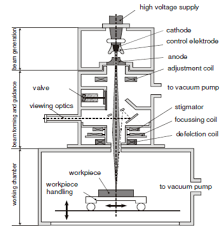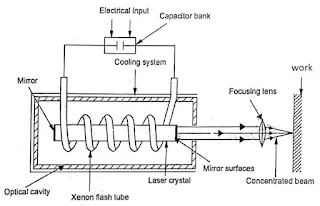welding - To join pieces of metal by heating them and pressing them together.
There are many different types of welding, but some of the most common include:
Shielded metal arc welding (SMAW)
Shielded metal arc welding (SMAW), also known as "stick welding," is a manual welding process that uses an electrode (a stick or rod) coated in flux to create an arc between the electrode and the workpiece. The electrode is made of a metal alloy that melts and becomes part of the weld. The flux coating on the electrode creates a shielding gas that protects the weld from contamination by the atmosphere.
The electrode is held in a holder and the welder strikes an arc between the electrode and the workpiece. As the electrode melts and becomes part of the weld, the welder must maintain a consistent distance between the electrode and the workpiece and maintain a consistent speed and angle of travel.
SMAW is a versatile welding process that can be used on a variety of metals, including steel, aluminum, and stainless steel. It is often used in the construction, shipbuilding, and repair industries. Some of the advantages of SMAW include its portability and low cost, but it also has some limitations such as less precise control over the weld, and it generates a lot of spatter and smoke.
Gas metal arc welding (GMAW)
Gas metal arc welding (GMAW) is a type of welding process that uses a continuously fed wire electrode and an inert or semi-inert gas to shield the weld pool from contamination. It is also known as Metal Inert Gas (MIG) welding or Metal Active Gas (MAG) welding. GMAW is commonly used to weld aluminum and other non-ferrous metals, as well as certain types of steels and alloys. The process is relatively easy to use and can be automated, making it well-suited for high-production environments. It is also widely used in industries such as construction, automotive and aerospace.
Gas tungsten arc welding (GTAW) - Also known as "TIG welding," this process uses a non-consumable tungsten electrode to create an arc and a separate filler metal to create the weld.
Flux-cored arc welding (FCAW)
Flux-cored arc welding (FCAW) is a welding process that uses a continuously fed tubular electrode that is filled with a flux powder. The electrode and the workpiece are both connected to a power source, creating an electric arc that melts the electrode and the workpiece. The flux within the electrode creates a shield around the weld area, protecting it from atmospheric contamination and providing additional chemical elements to the weld.
FCAW is similar to Gas Metal Arc Welding (GMAW) in many ways, but it does not require an external shielding gas and is often used in outdoor or windy conditions where GMAW may not be feasible. It also has higher deposition rates, making it a more efficient process for thicker materials.
However, FCAW also has some disadvantages, such as increased smoke and fume generation, and the need for a special machine to feed the electrode. Additionally, the flux within the electrode can create slag that needs to be removed after welding, and the process is not suitable for welding aluminum.
Submerged arc welding (SAW)
Submerged arc welding (SAW) is a welding process that uses a consumable electrode that is fed through a welding gun and into the weld joint. The electrode and the workpiece are both connected to a power source, creating an electric arc that melts the electrode and the workpiece. Unlike other welding processes, the arc is submerged under a layer of flux, which creates a shielding gas that protects the weld area from atmospheric contamination.
SAW is a highly efficient process that can be used to weld thick materials, and the flux used in the process also provides additional chemical elements to the weld, which can improve its strength and ductility. Additionally, the submerged arc process produces minimal smoke and sparks, making it a safer choice for welding in confined spaces or in areas with a high risk of fire.
However, SAW also has some disadvantages, such as the need for a special machine to feed the electrode, and the process can be difficult to learn for new welders. Additionally, the flux used in the process can create slag that needs to be removed after welding, and the process is not suitable for welding aluminum.
Resistance welding
Resistance welding is a welding process that uses electrical resistance to generate heat and melt the metal at the point of contact between the two pieces of metal being joined. The process uses two electrodes, one positive and one negative, that are pressed against the workpiece and an electrical current is passed through the electrodes, creating resistance and generating heat at the point of contact. This heat melts the metal and forms a weld.
There are several types of resistance welding, including:
- Spot welding: which is used to join two or more overlapping metal sheets together.
- Seam welding: which is used to join two metal sheets together in a continuous weld along a line.
- Projection welding: which is used to join two metal parts together with small projections on one of the pieces of metal.
Resistance welding is a highly efficient process that is capable of welding very thick materials, and it is also relatively inexpensive and easy to set up. Additionally, it is a very fast process and can produce high quality welds with minimal deformation of the workpiece.
However, resistance welding also has some disadvantages, such as the need for precise alignment of the electrodes, and the process is not suitable for welding dissimilar materials. Additionally, the process generates a lot of heat, and the electrodes can wear out quickly and need to be replaced frequently.
Electron beam welding
Electron beam welding (EBW) is a welding process that uses a beam of high-energy electrons to generate heat and melt the metal at the point of contact between the two pieces of metal being joined. The process uses an electron gun, which generates a beam of high-energy electrons, and a workpiece, which is placed in a vacuum chamber. The electron beam is directed towards the workpiece, creating a small, concentrated area of heat that melts the metal and forms a weld.
EBW is a highly precise and accurate welding process that can produce very high-quality welds with minimal distortion or deformation of the workpiece. The process is also very fast and can be used to weld a wide range of materials, including metals, ceramics, and composites. Additionally, EBW can be used to weld very thick materials, and it can also be used to weld materials that are sensitive to heat, such as titanium and inconel.
However, EBW also has some disadvantages, such as the high cost of the equipment and the need for a vacuum chamber to be used during the welding process. Additionally, the process can be difficult to learn for new welders, and it is not suitable for welding large or complex parts that require multiple passes.
Laser beam welding
Laser beam welding (LBW) is a welding process that uses a highly focused and intense beam of light to generate heat and melt the metal at the point of contact between the two pieces of metal being joined. The process uses a laser, which generates a beam of light, and a workpiece, which is placed in a specific position with respect to the laser beam. The laser beam is directed towards the workpiece, creating a small, concentrated area of heat that melts the metal and forms a weld.
LBW is a highly precise and accurate welding process that can produce very high-quality welds with minimal distortion or deformation of the workpiece. The process is also very fast and can be used to weld a wide range of materials, including metals, ceramics, and composites. Additionally, LBW can be used to weld very thin materials, and it can also be used to weld materials that are sensitive to heat, such as titanium and inconel. The process is also highly flexible and can be automated.
However, LBW also has some disadvantages, such as the high cost of the equipment and the need for a high level of skill to operate it. Additionally, the process is not suitable for welding large or complex parts that require multiple passes, and the process generates high amounts of heat, which can damage the workpiece.
Plasma arc welding
Plasma arc welding (PAW) is a welding process that uses a plasma arc to generate heat and melt the metal at the point of contact between the two pieces of metal being joined. The process uses a plasma torch, which generates a plasma arc, and a workpiece, which is placed in a specific position with respect to the plasma arc. The plasma arc is directed towards the workpiece, creating a small, concentrated area of heat that melts the metal and forms a weld.
PAW is similar to Tungsten Inert Gas (TIG) welding in many ways, but the plasma arc is hotter and more focused than the TIG arc, which allows for faster welding speeds, deeper penetration and a smaller heat-affected zone. The process is also highly versatile and can be used to weld a wide range of materials, including metals, ceramics, and composites. Additionally, PAW can be used to weld very thin materials, and it can also be used to weld materials that are sensitive to heat, such as titanium and inconel.
However, PAW also has some disadvantages, such as the high cost of the equipment and the need for a high level of skill to operate it. Additionally, the process is not suitable for welding large or complex parts that require multiple passes, and the process generates high amounts of heat, which can damage the workpiece.
Stud welding
Stud welding is a process that uses an arc or resistance welding process to attach a fastener, typically a metal pin, stud, or bolt, to a workpiece. The fastener, or stud, is held in a special welding gun and is inserted into the workpiece, where an electric arc or resistance is used to melt the metal at the point of contact and fuse the stud to the workpiece.
There are two main types of stud welding: arc welding and resistance welding. In arc welding, a short-circuit transfer process is used to create the weld, while in resistance welding, heat is generated by resistance to the flow of current between the stud and the workpiece.
Stud welding is a highly efficient process that can be used to quickly and easily attach a wide variety of fasteners to a wide range of materials, including metals, ceramics, and composites. The process is also very versatile, and can be used to attach fasteners in a wide range of positions and orientations. Additionally, stud welding can be done quickly, with minimal heat distortion and deformation of the workpiece.
However, stud welding also has some disadvantages, such as the need for precise alignment of the stud and the workpiece, and the process is not suitable for welding large or complex parts that require multiple passes. Additionally, the process generates a lot of heat, and the electrodes can wear out quickly and need to be replaced frequently.
Tags Mech IdeasSubscribe Our Newsletter











0
Post a Comment